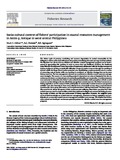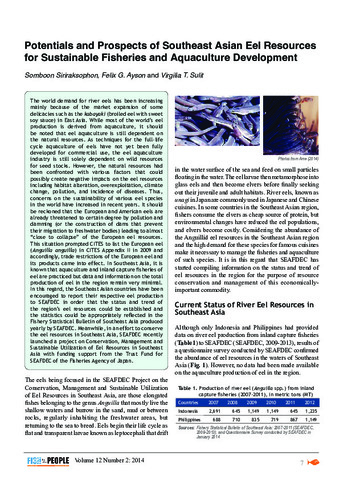Status of resource management and aquaculture in Malaysia
- Global styles
- MLA
- Vancouver
- Elsevier - Harvard
- APA
- Help
Share
Abstract
Malaysia is a maritime nation and its fishing industry is a source of income for 134,000 fishermen. In 2012, the fisheries sector produced 1.7 million tons of fish valued at RM10.8 billion and generated trade worth RM6 billion. The landings from capture fisheries are expected to increase from 1.32 million tons in 2010 to 1.76 million tons in 2020 at an annual growth rate of 2.9%. In 2012, 65% of total catch was contributed by the coastal fisheries as compared to 35% from deep sea fishing. Landing from deep sea fishing is expected to rise from 381,000 tons in 2012 to 620,000 tons in 2020. Deep sea fishing has been identified for its potential to contribute to the increase in the country s fish production. With a growing population and an increasing preference for fish as a healthy source of animal protein, the National Agro-food Policy (2011-2020) estimated that the annual demand for fish will increase to 1.93 million tons by the year 2020. The Department of Fisheries (DOF) has developed the Capture Fisheries Strategic Management Plan (2011-2020) based on three main documents i.e.; National Agro-food Policy (NAP, 2011-2020), Department of Fisheries Strategic Management Plan (2011-2020), and Malaysia National Plan of Action on Sustainable Fisheries for Food Security towards 2020.
Aquaculture is now being promoted in Malaysia as an important engine of growth and eventually to become the mainstay of the nation s economy. Situated in a region with abundant supply of land and water, two determinant factors for aquaculture activities, Malaysia has always strived to ensure that this sector is not sidelined in their development efforts. With a growing population and an increasing preference for fish as a healthy source of animal protein, it has been estimated that the annual demand for fish will increase to 1.7 million tons in 2011 and further to 1.93 million tons by 2020. From the present annual aquaculture production of about 525,000 tons, this output would need to be raised to 790,000 tons to meet the projected demand by 2020. In a move to develop the aquaculture industry, the DOF, has initiated the Aquaculture Industrial Zone (AIZ) Program involving the development of 49 zones, located across Malaysia, which will be used for culture of various types of high value aquatic species. The DOF has identified several strategic areas that would be developed for downstream activities such as fish seed production, feed mills, fish processing plants, and other supporting industries. Aquaculture is also currently listed amongst the 16 Agro-food s Entry Point Projects (EPP) of the National Key Economic Area (NKEA). The government aims to double the Agro-food sector s contribution to Gross National Income (GNI) from Malaysian Ringgit (RM) 20.2 billion in the year 2010 to RM49.1 billion by 2020, or an increase of RM28.9 billion.
Suggested Citation
Yusoff, A. (2015). Status of resource management and aquaculture in Malaysia. In M. R. R. Romana-Eguia, F. D. Parado-Estepa, N. D. Salayo, & M. J. H. Lebata-Ramos (Eds.), Resource Enhancement and Sustainable Aquaculture Practices in Southeast Asia: Challenges in Responsible Production of Aquatic Species: Proceedings of the International Workshop on Resource Enhancement and Sustainable Aquaculture Practices in Southeast Asia 2014 (RESA) (pp. 53-65). Tigbauan, Iloilo, Philippines: Aquaculture Dept., Southeast Asian Fisheries Development Center.
Type
Conference paperISBN
9789719931041
Related items
Showing items related by title, author, creator and subject.
-
Community fishery resources management on Malalison Island, Philippines: R & D framework, interventions, and policy implications
Agbayani, Renato F.; Baticados, Didi B.; Siar, Susana V. (Taylor & Francis, 2000)In 1991, the Aquaculture Department of the Southeast Asian Fisheries Development Center launched a community-based fishery resources management project on Malalison Island, in central Philippines, to help conserve the ...88 Total citations0 Recent citations2.5 Field Citation Ration/a Relative Citation Ratio -
Socio-cultural context of fishers’ participation in coastal resources management in Anini-y, Antique in west central Philippines
Aldon, Ma. Eva T.; Fermin, Armando C.; Agbayani, Renato F. (Elsevier, 2011)The vicious cycle of poverty, overfishing and resource degradation in coastal communities in the Philippines calls for action that will address the problem of declining fish catch and degraded fish habitats. The literature ...2424 Total citations3 Recent citations2.65 Field Citation Ration/a Relative Citation Ratio
-
Potentials and prospects of Southeast Asian eel resources for sustainable fisheries and aquaculture development
Siriraksophon, Somboon; Ayson, Felix G.; Sulit, Virgilia T. (Secretariat, Southeast Asian Fisheries Development Center, 2014)The world demand for river eels has been increasing mainly because of the market expansion of some delicacies such as the kabayaki (broiled eel with sweet soy sauce) in East Asia. While most of the world’s eel production ...






